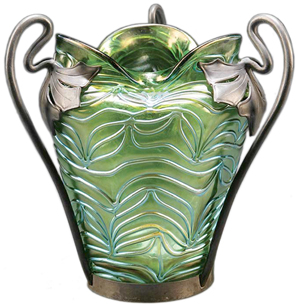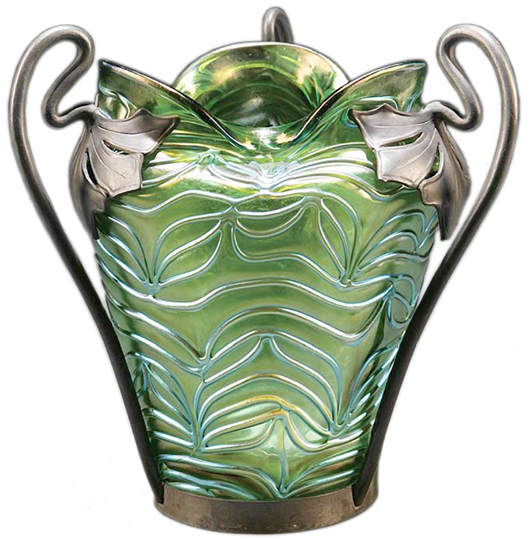
Ancient Roman iridescent glass dug up in Israel is now being featured in modern jewelry. One of the jewelry designers told viewers of a late-night shopping channel that the thin layer of iridescence called “patina” was taken from the ancient glass and assembled flake by flake on a base used to create new jewelry. A chemical reaction causes buried glass to form the iridescent layer.
We have seen 1950s bottles buried in a damp location that show this type of iridescence.
Artists have admired this glass iridescence since the early 1800s. In 1817, a man from Scotland patented a way to iridize glass, but the glass that collectors like today, the kind with a golden iridescence, was made by Ludwig Lobmeyr of Austria-Hungary in 1873. Other glass artists, including Louis Comfort Tiffany, began making their own type of iridescent glass. Some of the factories that made gold iridescent glass and the date they started are: Glasfabrik Johann Loetz-Witwe (1890), Wilhelm Kralik Sohn (1890s), Tiffany (1896), Koloman Moser (1900), Quezal Art Glass Co. (1901) and Steuben Glass Co. (1903).
Carnival glass, a less-expensive and very different-looking type of iridescent glass, was made after 1908. Collectors and even experts often cannot identify the maker of a gold iridescent glass piece because the pieces are all so similar. And modern glassmakers can produce very similar glass pieces, too, so there is much confusion. The most expensive and most popular is Tiffany gold glass.
Q: I would like to know the age and make of my cast-iron toy gun. It’s marked “TG-27” and has a funny nub on the bottom and a short barrel. It probably opens at the grip. My brother repainted the entire gun to cover up rust.
A: Your toy gun is a cap gun made by the National Toy Co. The nub on the bottom of the grip lifts up to show where the caps should be loaded. Although the company didn’t officially incorporate until 1914, your cap gun likely dates from 1911. The company’s products were successful and sold in stores like FAO Schwarz. Because your cap gun is repainted, its value is very low.
Q: Please settle a dispute between my husband and me about our small table. It has been in my family for years. We think it’s made of iron. It has two pierced oval shelves and a marble top and it’s marked “B & H” and “1646.” The paint is chipped. I say it should not go to a landfill and my husband insists it should. Who is right?
A: Your iron table was made by Bradley & Hubbard Manufacturing Co. Walter Hubbard and his brother-in-law, Nathaniel Lyman Bradley, started making cast-metal clocks, call bells, lamps, chandeliers, sconces, bookends, frames, andirons and sewing birds in 1854 in Meriden, Conn. The company was sold to Charles Parker in 1940. During the late 1800s and early 1900s, Bradley & Hubbard made many types of small ornate tables and stands to hold plants, flowers, calling cards, smoking accessories and inkstands. The tables and stands sell today for about $150 to $350, depending on condition. All Bradley & Hubbard products are collectible. Don’t throw the table away.
Q: A Dr. Scholl’s counter display has been in my family for years. It advertises “Dr. Scholl’s Zino-pads. For Corns, Callouses & Bunions.” The display has a pair of men’s feet on it and contains a flickering light bulb that shines through a red lens to simulate pain. What is its value?
A: Dr. Scholl’s was founded in Chicago in 1906 by podiatrist William Mathias Scholl. Scholl was working for a local shoe retailer when he realized the market potential for shoes that addressed common foot problems. He took night classes at a medical school and received his degree in 1904. When Scholl hired salesmen, he paid them higher wages if they took a podiatric course. On his first trip to Europe, Scholl personally sold arch supports to Kaiser Wilhelm II of Germany. The company used many different styles of counter displays to advertise its products in drugstores. Your display is unusual because it has electric components. A nonelectrical vintage Dr. Scholl’s counter display recently sold for $144 at auction. Any large advertising sign with lights is worth hundreds of dollars.
Q: I have a scrapbook that belonged to my great-grandfather and then my grandfather. It’s a scrapbook all about the Villa Igiea in Palermo, Sicily. It has about 145 pages and is filled with newspaper clippings from the early 1900s. We would like to keep it in the family, but wonder what it might be worth. Who might be interested in it?
A: Collectors and libraries value letters, cards, documents and photographs of famous people. If the person who kept the scrapbook isn’t famous, the value of material in an old scrapbook is minimal unless the photos and letters relate to a historic event. Condition is always important, too. Collectors don’t like newspaper clippings as much as they like postcards, trade cards and “scraps” (small die-cut colored pictures). They will pay $1 to $10 for common examples and more than $100 for rarities. If your scrapbook includes more than clippings, you may find it has more value by taking it apart and donating or selling the individual photos, postcards and scraps.
Tip: Do not display carnival glass made before 1910 in direct sunlight. The glass, introduced in 1907, will turn purple or brown and its iridescent finish may fade.
Terry Kovel answers as many questions as possible through the column. By sending a letter with a question, you give full permission for use in the column or any other Kovel forum. Names, addresses or email addresses will not be published. We cannot guarantee the return of any photograph, but if a stamped envelope is included, we will try. The volume of mail makes personal answers or appraisals impossible. Write to Kovels, Auction Central News, King Features Syndicate, 300 W. 57th St., New York, NY 10019.
CURRENT PRICES
Current prices are recorded from antiques shows, flea markets, sales and auctions throughout the United States. Prices vary in different locations because of local economic conditions.
- Melamine dinnerware set, Trumpet Ware, white plates, brown cups and bowls, original box, Trump Plastics Co., 1960s, five four-piece place settings, salt and pepper, 22 pieces, $30.
- The Junk Yard Game, target game, pinball action, box, Ideal, 1975, $35.
- Fire-King advertising mug, “Col Ballroom, The Family Name in Dancing,” Davenport, Iowa, white glass, red logo of couple dancing, Anchor Hocking, 1940s-50s, 3 1/2 inches, $40.
- Little Orphan Annie and Sandy ashtray, lusterware, Annie in red dress sitting on edge of tray, Sandy by her side, “Made in Japan,” 1930s, 3 x 4 inches, $75.
- Space Ranger Walkie Talkies, two units, drawing of boy in spacesuit on box, Transette, 1960s, $90.
- Planters Peanuts cocktail glasses, red bowl, blue base, clear Mr. Peanut figural stem, paper ring tags, 5 1/8 in., set of four, $125.
- Hooked and braided rug, wool and cotton, diamond pattern, beige, gray and black with turquoise and pink nosegays, early 1900s, 30 x 50 inches, $245.
- Kate Greenaway figural napkin ring, silver plate, boy lying on his stomach next to dog, unmarked, James W. Tufts. $550.
- Rose O’Neill Skootles doll, pink and white sunsuit and bonnet, white leather shoes, pink socks, Cameo Doll Co., 1920s, 16 inches, $650.
- Refectory table, walnut, carved, trestle supports, chamfered stretcher, Continental, 19th century, 32 x 108 inches, $3,105.
Prepublication offer: The best book to own if you want to buy or sell or collect-and if you order now, you’ll receive a copy with the author’s autograph. The new Kovels’ Antiques & Collectibles Price Guide, 2013, 45th edition, is your most accurate source for current prices. This large-size paperback has more than 2,500 color photographs and 40,000 up-to-date prices for more than 775 categories of antiques and collectibles. You’ll also find hundreds of factory histories and marks, a report on the record prices of the year, plus helpful sidebars and tips about buying, selling, collecting and preserving your treasures. Available online at Kovelsonlinestore.com; by phone at 800-303-1996; at your bookstore or send $27.95 plus $4.95 postage to Price Book, Box 22900, Beachwood, OH 44122.
© 2012 by Cowles Syndicate Inc.

ADDITIONAL IMAGE OF NOTE


